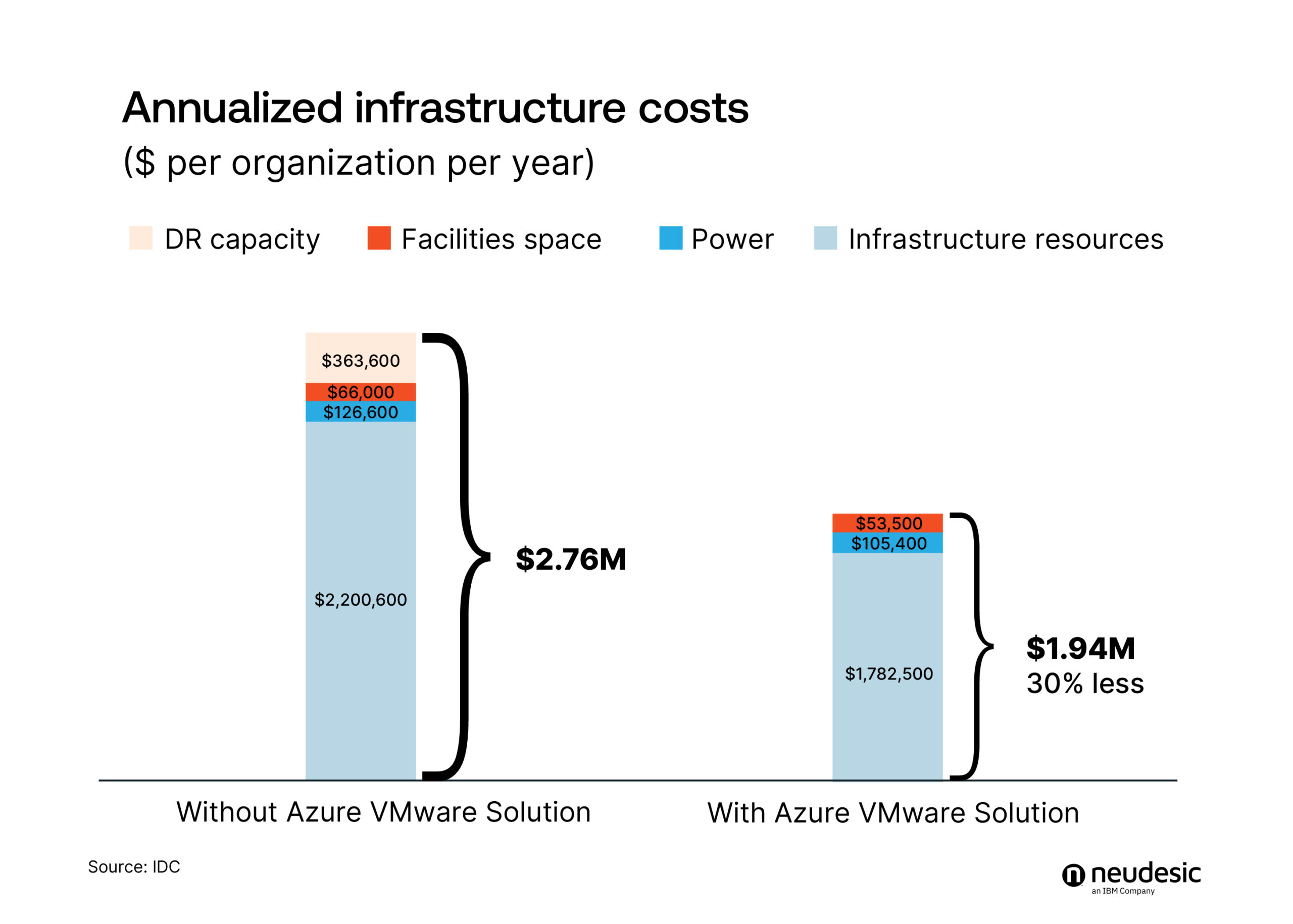
Since the acquisition of VMware by Broadcom in 2023, IT managers have been concerned about bundled services and the company’s future operations. This has come to a head over the last year as reports emerged around Broadcom’s desire to simplify VMware’s licensing model, switch from a perpetual to a subscription-based pricing model, and increase its annual costs by as much as 600%.
As a growing number of businesses consider switching from VMware, IT leaders must weigh the costs, time, and effort of leaving their current state against alternative options. However, in traditionally resource-constrained IT operations, what alternatives do executives have when migration to competitors is neither within budget nor feasible? In this blog, we examine the realities and common misconceptions of one enticing option: Azure VMware Solutions (AVS).
Strategic and operational factors to consider before adopting Azure VMware Solution
When considering alternatives for crucial assets such as a well-matured VMware environment, it is essential to understand the implications before adopting a new technology, especially when changes in pricing and licensing models come into play. Cloud migrations help save costs and optimize resources. A migration also enables improving data center capabilities by utilizing Azure’s services. Shifting to AVS allows for keeping current investments and migrating the cluster as-is with a managed service, making user adoption easier and reducing migration efforts and time. The Azure Hybrid Benefit includes all the VMware licenses within the dedicated hosted solution and can mitigate the cost of core licenses for Windows Server and SQL Server, as well as provide extended security updates at no additional cost when migrating to Azure. However, there are some considerations worth mentioning:
- Hardware and estate renewals: When was your expected hardware refresh? VMware-certified hardware and indirect costs (i.e., the data center) are significant positions on a recurring basis.
- Data volume: How much data gets processed? Cost advantages are substantial for enterprises with limited data volume.
- Cloud strategy: Are you already an Azure customer? AVS can pave the way to cloud-native migrations.
With these key considerations in mind, it is worth addressing common misconceptions about switching to AVS to gain a thorough understanding of the opportunities and features, including cost considerations related to licensing, compute, storage, network, VMware, backup solutions, bandwidth, Windows Server, SQL Server, extended security updates, and overall configuration options.
Myths of AVS adoption
The features and benefits of AVS are convincing, but it is essential to debunk common misconceptions and myths before making decisions. Through an informal survey of online VMware communities, we’ve noticed that there are some misconceptions worth addressing to help you make an informed decision. Evaluating the cost and scalability benefits of AVS compared to on-premises infrastructure can highlight significant advantages.
One common myth is that AVS is not cost-effective. However, leveraging shared infrastructure within Azure can offer substantial cost savings and scalability, making it a compelling option for organizations.
Myth #1: AVS has no cost savings benefit to on-premises costs
A common misconception is that AVS has little-to-no cost advantage over current on-premises installations. This misconception is likely because of AVS’s capability to take over entire installations, and therefore, one would expect the exact cost for basically the same service. However, this equation neglects typical indirect costs such as procurement processes for hardware, operation, and maintaining a physical location besides the indirect costs of supporting and administering these complex environments. Moving to the cloud eliminates the majority of these costs. Additionally, Microsoft offers a variety of funding programs to make the case for a more affordable migration to their premises, helping leaders save 50% or more on VMware costs. This migration not only ensures cost predictability and reduced overheads but also provides operational consistency.
Several cost factors can significantly impact overall VMware spending, including:
Reserved instances: Reserved instances offer businesses a substantial discount in exchange for a long-term commitment. These commitments are typically available in one, three, or five-year terms and can result in up to a 20% discount compared to pay-as-you-go pricing. For AVS, the five-year term is only available through promotional offerings.
Hybrid benefit: The Hybrid Benefit feature allows discounts on existing on-premises licenses for Windows Server or MS SQL Server. Furthermore, the Hybrid Benefit includes free extended security updates for previously licensed Microsoft products.
Dynamic allocation: Azure’s flexibility enables businesses to adapt to changing user behavior and needs, with clusters and servers able to quickly scale and allocate resources to meet the actual requirements.
These discounts add up to a significant decrease in spending, while also driving business value through the flexibility of cloud infrastructure.
Myth #2: Migration to AVS is complex, hence not worth the complexity concerns
The general perception is that migrations are costly and complex to perform. This misconception also became apparent in our sentiment analysis for AVS. However, from our experience, it has been quite the opposite with AVS. VMware advertises the lift-and-shift scenario to AVS as being at least 42% faster than comparable migration projects. Current VMware on-premises customers can move their environment to the public cloud infrastructure with only a few adjustments and preliminary work necessary.
Furthermore, Microsoft developed helpful tools to address the complexity concerns of these migration processes, including:
Azure Migrate Service: Many of our customers benefit from Azure Migrate Service, which assesses, validates, and provides a streamlined process for migrating on-premises VMware workloads to Azure.
Microsoft Assessment: The Microsoft Assessment for AVS is a good starting point for every initiative. The tool is a fast and convenient way to get a rough estimation of the complexity along with targeted recommendations.
In our experience, the transition to AVS is a seamless process. There are several good options to further reduce existing complexity, including scoped and partial migration efforts. With AVS, it is possible to migrate non-critical workloads as part of a POC selectively. Clients with large installations often prefer the scoped rehosting of selected clusters. This way, migration complexity is comparably low while already enabling thorough evaluation and maintaining service availability.
Myth #3: Shifting critical VMware workloads to rented hardware
Shifting critical workloads to the cloud usually means giving up immediate, physical access to assets, which can be a concern when considering disaster recovery and high-availability scenarios. In Azure, there are several ways to replicate workloads anywhere on Earth. Microsoft operates in over 60 regions with more than 30 locations available for AVS. Customers get access to this worldwide replication to make environments fault-tolerant. This offers the opportunity to implement effective processes for worst-case scenarios and support business continuity.
Myth #4: Migrating to AVS is another layer of vendor lock-in
Vendor lock-ins are a general concern for every business, and being heavily invested in VMware is one. There is the perception that AVS is another way to further lock in users. This misconception is likely because AVS replaces the on-premises hardware with its bare metal. However, AVS is not a lock-in per se, as competing and very similar offers are available, allowing for a manageable migration if needed. This flexibility became apparent as we recently assisted a customer in migrating from Google Cloud VMware Engine to AVS.
We observe and can confirm that AVS is not the long-term solution for all of our clients. AVS often serves as an extended runway to re-evaluate and implement longer-term solutions. That allows businesses to shift workloads on cloud infrastructure if needed. With this in mind, we recommend two options to our clients:
- AVS as an intermediate solution: Migrate to cloud-native or competitors at own pace
- AVS as a long-term solution: VMware with long-term cost savings
The previously described lift-and-shift of VMware assets onto AVS could be an intermediate step toward these migration scenarios. From there, companies can either migrate away from VMware to cloud-native workloads or stay committed to the solution. Either way, expected costs are visible and available upfront, while prices and licenses are negotiated directly with Microsoft instead of VMware.
Myth #5: AVS is only worth considering in highly regulated industries
It may be ambiguous at first that operating a private cloud on top of a public cloud infrastructure contributes to these myths. However, private clouds come with features required to comply with regulatory requirements for data residency, storage, and processing. VMware on-premises already conforms to several compliance requirements that AVS hardens even further. It is worth mentioning that AVS is FedRAMP High certified, enabling the government to use this service and businesses working with authorities. Meeting these or similar standards is optional for most companies operating on VMware. We believe this misconception results from different aspects:
- Confusion: Getting a certified service, although not needed
- Cost: Resulting from buying in these certification standards
With extensive cost savings options described in Myth #1, these standards and certifications do not directly impact the overall service bill. Instead, AVS allows IT professionals to concentrate on creating actual business value without sacrificing the investments and expertise they’ve gained from VMware on-premises. This fact is essential for small and medium-sized businesses that operate on a tighter budget and have fewer resources. Our perspective is that AVS is not solely for governmental organizations but also presents a valuable opportunity for smaller businesses and enterprises to free up crucial resources while maintaining good practice and regulatory compliance. Microsoft offers a comprehensive overview of the compliance standards met at their different data centers. That way, Microsoft ensures a confident transition of businesses to the cloud.
Myth #6: Running unsupported as concerns about VMware partnerships arise
Our survey study revealed that the idea of continuing operations was unsupported. This idea either results from protest against the new license model or to cut down on costs and thrives amidst rumors on whether Broadcom/VMware will break partnerships with cloud providers similar to the recent development with Amazon Web Services. However, Microsoft recently confirmed its strategic partnership with VMware and its commitment to manage licensing and support directly instead of Broadcom/VMware and its resellers.
We recommend not skipping support contracts to save costs because this cut leaves you vulnerable to:
- Security risks
- Compliance issues
- Compatibility challenges
- Business continuity concerns
AVS, as a managed service, not only provides businesses with the required infrastructure for operations but also offers a more affordable support contract. This contract, which is directly with Microsoft, can leverage significant benefits for AVS customers, given Microsoft’s market power. It offers a secure and more stable support ecosystem.
Transitioning to AVS with confidence
In conclusion, navigating the transition from VMware to Azure VMware Solutions (AVS) can seem daunting due to widespread myths and misconceptions. However, as we’ve explored, AVS offers substantial benefits including cost savings, simplified migration processes, and enhanced support and flexibility. By debunking these myths, it’s clear that AVS presents a compelling alternative, allowing businesses to leverage their existing investments while optimizing their IT infrastructure. As enterprises face increasing pressure to innovate and cut costs, understanding the true value of AVS can provide a strategic advantage in maintaining a competitive edge and operational efficiency. Embracing AVS not only addresses current challenges but also paves the way for innovation and future growth.
Have questions? Want to talk to the AVS certified experts at Microsoft’s Azure Global Partner of the Year? We’d love to chat.
Related Posts
